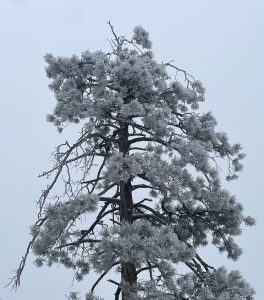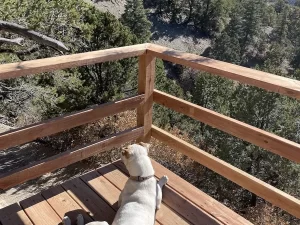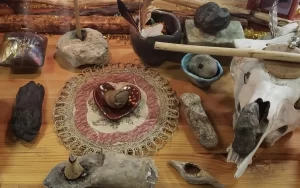by Florian Birkmayer, MD
Psychedelic therapy can be considered one of the oldest forms of therapy for soul healing and at the same time is now considered cutting edge in biomedical medicine after decades of being shunned. Using essential oils for psychedelic therapy support has not been discussed at all and as far as we can tell, we may be the first to use essential oils for psychedelic therapy support.
A number of traditional indigenous societies, in almost all parts of the world, work with plant spirit medicines, which seems a more holistic and respectful term, for soul healing. (The only indigenous traditional society that doesn’t use plant spirit medicines or psychedelic plants are the Intuit, which some speculate is due to the lack of psychoactive plants growing near the Artic.) In an oversimplified way, psychedelic therapy can be defined as the use of mind-altering or psychedelic plants and mushrooms for the purpose of healing a disease or imbalance that can manifest in the physical, emotional, mental and spiritual bodies of an individual or group. The setting for this therapy can be individuals or groups. Most of the time, a shaman or similar person or group of persons guides the experience.
Starting with R. Gordon Wasson’s ‘discovery’ of Maria Sabina, a Mazatec traditional healer who working with psilocybin mushrooms, in 1955, there has been growing interest in western societies in ‘psychedelic therapy.’ (The negative impact of R. Gordon Wasson and those who followed him on Maria Sabina’s family and traditional Mazatec has to be acknowledged.) I realize this is an oversimplified way of introducing the history of psychedelic therapy. Although there was interest in psychedelic molecules before then, such as anthropologists studying the use of peyote, the Nazis experimenting with mescaline on people incarcerated at Dachau and the discovery of LSD in 1943, to me these efforts were not with the intention of healing. Sandoz, the company for which Hoffman worked when he discovered LSD, used to give LSD away freely to any researcher or doctor who wanted to experiment with it, because they didn’t know what healing potential it offered. After a period of promising research in the 50’s and early 60’s (Humphrey Osmond who coined the term ‘psychdelic’, and others), along with some truly revolting attempts to use these molecules for mind control (MK Ultra, Donald Ewen Cameron), the recreational use of psychedelics spread far and wide, the healing intentions and sacred focus were widely forgotten or obscured by sensationalist news stories and there was a widespread backlash against psychedelics. Their healing promise and the sacred tradition, along with the accumulated wisdom, was mostly forgotten.
Over the last 25 years, there has been a renaissance of official, academic research into psychedelic therapy, mostly focusing on psilocybin, MDMA, LSD and ketamine. Mainstream interest in and acceptance of these treatment approaches is spreading, as evidenced by more and more books and documentaries being released, such as Michael Pollan’s ‘How to Change your Mind’ (which to me has some profound limitations, while it serves as a basic introduction.)
At the same time, there has been a long and vibrant tradition of ‘underground’ psychedelic therapy, which has helped many people and kept the sacred traditions alive while gathering experiential wisdom. It is from this practice-based evidence that the importance of having a clear intention and having a pair of experienced sitters has been demonstrated, which has then also been reaffirmed in official studies.
I have worked with ketamine for psychiatric indications on and off since 2011. Ketamine is currently the only FDA-approved medication that can be used for psychedelic therapy. Most of the research on ketamine has focused on outcomes measures and rating scales, e.g. for depression, PTSD, etc., as well as the neurochemical and neurobiological changes that may contribute to ketamine’s benefits, which include that it works on the NMDA receptor and appears to increase neuronal plasticity, which is the ability of neurons in the brain to form new connections and thus establish new patterns of thinking and behaving. Myself and a few others are also realizing the unique therapeutic potential of the psychedelic experience ketamine can offer.
The potential benefits of the psychedelic experience of ketamine, which some consider rather unique, have been mostly overlooked, although that is slowly changing. Both due to the psychedelic experience and neuronal plasticity effects, I think that ketamine and other psychedelics disrupt the Default Mode Network. I have started to suspect more and more that the Default Mode Network, a widespread network of connections and centers in the human brain, is involved in most ongoing/long-standing emotionally distressing and dysfunctional patterns, including depression, anxiety, PTSD/trauma-spectrum, addiction and other dysfunctional unconscious patterns many of which are socially sanctioned, such as consumerism and ideological extremism, both of which are destroying nature and the unifying, mutually humanizing bonds of traditional society.
I have combined ketamine with essential oils, which in my experience can significantly enhance the healing process that ketamine offers. After briefly discussing how ketamine works, I will discuss a few essential oils that I have recently used with clients receiving ketamine and their benefits.
Ketamine is a dissociative anesthetic that has shown great promise as a novel treatment for depression (1), PTSD and chronic pain. In my practice, I have also seen it provide benefit for OCD (Obsessive Compulsive Disorder) and there is early research to support this (2) and other conditions, that have not responded to more common medications. Ketamine has been FDA approved since the 1960s. Ketamine is most commonly given intramuscularly or intravenously, both in clinical practice and in studies, although there are other ways to deliver it, such an inhalation devices and lozenges. A recent survey of practitioners and review of the literature (3) indicated that ketamine has a low rate of serious side effects and that long-term treatment is reasonably safe.
Ketamine’s dissociative effects mean that when it is given intramuscularly in sufficient dose, the person receiving it experiences dissociation from being in the body and most of the senses. (Note: This dissociation is quite different from the dissociation seen in PTSD and trauma-spectrum disorders.) It can be almost impossible to walk, write or talk and people report being disconnected from their senses, having difficulty with seeing, hearing and proprioception. However, the sense of scent seems to be uniquely enhanced through ketamine and people report experiences of synesthesia or meeting the spirit of the plant through the aromatic molecules in an essential oil.
One aspect of how this may happen lies in neuroanatomy. All senses, except the sense of smell, are processed through an organ in the brainstem called the thalamus. It’s like a mixing board for most sensory input. The reason you’re not feeling the clothes on your skin right now is that the thalamus filters that out. The reason you can focus on a conversation with one person in a noisy setting is because the thalamus filters the sound. Your eyes only really see what the thalamus tells them to see.
Scent is different. The olfactory nerves in our nose and olfactory bulb go directly into the limbic system, a network of brain areas involved with memory and emotion. Scent is the only sense that is not filtered by the thalamus. Furthermore, many aromatic molecules cross through the skin into the bloodstream and across the blood brain barrier into the brain. We have olfactory receptors in most parts of our brain and almost every organ in. our body, so we literally don’t just smell with our noses but our entire body and brain. So even and especially during the ketamine experience, when a person is dissociated and all other sensory input is ‘off-line’, one can still smell and experience the effects of aromatic molecules.
The most important consideration when using essential oils in combination with ketamine or other psychedelic therapy is that the essential oil is alive. Most essential oils are produced in a way that makes them dead. The quality we look for in an essential oil is ‘aliveness’ or what the alchemists and Hildegard von Bingen called ‘viriditas’ (4). To me, the essential oil of a plant is a manifestation of the soul of the plant. The essential oil is not a product or a tool, but really a living teacher and ally or plant spirit medicine. You can recognize this aliveness by the deep soul-to-soul connection you can experience when smelling an alive oil. I’ve personally gotten goosebumps and even cried when first smelling some of these special oils. As I’ve deepened my relationship with some of them, by working with them for years, they have become long-term living allies. To me, alive essential oils are profoundly psychoactive, both in combination with ketamine and other psychedelic therapies and by themselves.
Cathy and I have spent the last 5 years searching the world for the best, most alive essential oils for our work, which we call aromatic shamanism. Because we wanted reliable access to these special alive oils and wanted to provide them to our students and clients, we started cathysattars.com We currently get our essential oils from India, France, Croatia and have distilled a few ourselves here in the high desert of northern NM. Our Indian source is in Kannauj, a town along the Ganges that has centuries of tradition making attars, which is a traditional way of capturing fragile floral aromas in sandalwood essential oil. (Side Note: We try to be extremely conscientious about sustainability issues related to essential oils, including sandalwood, a topic for another time.) While there are a lot of adulterations and synthetics especially of attars, we visited Kannauj and feel we have a good relationship with our distiller there and some of his oils and attars have this aliveness. Our source in France, who is a former herbal student of my wife, lives in the Haute Loire and wildcrafts many of his essential oils.
We only work with approximately two dozen oils, because it’s much better to have a deep relationship with a few oils than a superficial relationship with hundreds. After this brief introduction about the importance of the quality of the oils, here’s a few essential oils that are great for psychedelic therapy:
Rose Attar is made from the precious, ancient roses cultivated in the Ganges valley near Kannauj captured in sandalwood essential oil. This has been mentioned in ayurvedic texts for centuries as a supreme medicine. The sandalwood is like a bowl or cupped hands that holds the aroma of the rose. Rose opens the heart. It’s like a spiritual hug. It’s great for reconnecting to our soul, receiving compassion and feeling self-compassion. I often use this first with clients new to ketamine, if they are nervous about the effects of ketamine. I also often use it in combination with other aromas, to provide a sense of being enveloped by love and compassion as the client explores the shadow issues more deeply during the ketamine experience.
Vetiver (aka Ruh Khus) made from the roots of an aromatic grass (Chrysopogon zizanioides) is a superb grounding oil. It is grown around the world to control soil erosion, which is symbolic of its grounding properties. Someone recently asked me to define ‘grounding’ and in the most simple way, grounding is the opposite of dissociation. For clients with severe PTSD, chronic dissociation is a survival mechanism, but also a problem, because it means we can’t really heal, because dissociation prevents us from feeling. Dissociation is often described as feeling that everything is unreal or under water, or that one feels like a head in the clouds or a head on a stick, with no awareness of the body and the present moment. Vetiver grounds us and reconnects us with our bodies, so we can feel, heal and be here now. Vetiver can also provide grounding, if necessary, during the more intense phases of ketamine therapy.
Galbanum is an ancient aromatic, mentioned in the old testament as one of the ingredients in ketoret, the sacred Jewish incense, where one of its purposes is to carry the sacred energy of the sabbath into the other days of the week. (Of course, the essential oil is a more recent creation.) I have found it’s a great aroma for committing to change and a new path, e.g. for helping clients with addiction commit to sobriety. It is great for helping us to stop delaying and waiting around and take action and commit to change. ‘The time is now,’ it seems to say. In combination with ketamine, it appears to really help commiting to the change the neuroplasticity of ketamine offers. It is also powerful in bringing up Shadow issues and allowing the client to go more deeply into the ketamine experience to retrieve insights and awarenesses that are ready to be released from the unconscious into consciousness.
Labdanum is probably the most sacred aroma of the ancient Egyptians who used a number of sacred scents as sophisticated spiritual technology. One of the scepters of Osiris is a labdanum resin collecting tool (often mistakenly called a flail) and it was central to his archetype and myth. We call it the Master of Shadows, because it brings Shadow issues to the surface like nothing else. We always say it should not be used without proper supervision. When someone needs to and is ready to go deeper, labdanum takes you there.
Yarrow: This essential oil is wild-crafted in France. Yarrow is the plant form of the Wounded Healer archetype, and we are all Wounded Healers. It’s great for reestablishing healthy boundaries and committing to the path of the Wounded Healer. In the context of ketamine, it allows us to fix energetic leaks and unhealthy overenmeshments.
Helichrysum: We recently found this amazing essential oil from Croatia. Helichrysum is great for releasing and healing childhood trauma. It allows us to cry long-suppressed tears and facilitates deep release coupled with a feeling self-compassion. You can finally allow yourself to feel without judgement. It also reminds you that it is much healthier to allow these deeply repressed feelings to surface than to be continually running from them. Helichrysum goes to the core, it doesn’t beat about the bush. In the context of ketamine, it’s great for those who lack self-compassion.
Marigold Essential Oil: The marigold essential oil we get from India is the only tagetes erecta (aka African Marigold aka Flor de Muerto i.e, the flower used in Mexico for Dia de los Muertos) essential oil that we know. There’s tagetes minuta essential oil which is not the same, and used in the perfume industry. This ‘true’ Marigold is really powerful for transgenerational trauma and connecting with the ancestors. I have to admit that since I’ve become aware of transgenerational trauma, it has been mind-boggling to realize how many clients’ current issues have a transgenerational component. I admit that perhaps this is not a ‘beginner’s oil’, but in the context of ketamine, may bring transgenerational stories to light that may have been the hidden source of traumas and patterns we have gone through in our life.
St. John’s Wort: Our French distiller is the only source for actual essential oil of St. John’s Wort that we know of. (The red infused oil is much more common, but not an essential oil.) It has antidepressant properties and can help let go of negative thought patterns.
We only work with essential oils by letting the clients smell them. We put a drop on a scent strip (aka perfume test strip) and then let the client hold it so they can bring it closer to their nose as needed. We usually work with one aroma at a time, sometimes two. We don’t use diffusers since it is much more difficult to control the amount of scent in a room and to clear the scent in a room between clients.
Ketamine uniquely amplifies the sense of scent and the ‘synesthesia’ can be amazing. With the help of ketamine one can really meet the spirit of the plant and the aromas are uniquely powerful in helping transform. Often when clients struggle to go deep enough or confront Shadow issues, the ketamine opens the door, so to speak, and certain aromas do the actual work. For example, galbanum or labdanum for Shadow issues and if needed some rose attar to provide comfort when the Shadow themes become intense.
Another important aspect when working with the psyche is to have a good framework or roadmap for the unconscious. This is a big topic and better for another post, but in brief, I find certain aspects of Jung’s model (i.e. the alchemical stages) quite helpful for navigating the unconscious realms and being able to tolerate in ourselves and in our clients the challenging emotions that come up when we heal, release traumas and individuate.
In my experience most conventional psychiatric medication management is countertransference, i.e. the prescriber is asking the client to take a medication because of their own anxieties about the client and this sends the implicit message that challenging emotions should be covered up. Instead, if we are able to recognize and behold the challenging emotions related to personal transformation, we can allow the natural processes of the psyche to heal and reconnect us.
The last thing I’ll say is that the alchemists were both the source of Jung’s model of the psyche (and in their own right explorers of the unconscious realms) and distilled some of the first essential oils and so I think it’s beautiful to bring back together these two aspects of the alchemical tradition for healing.
If you are ready to deepen your work with aromas, here are two options for next steps that I hope you will find helpful to get you started:
- I recently wrote a book “Essential Oils for Psychedelic Therapy” (Kindle, Paperback) that serves an introduction to how aromas and psychedelics synergize, the importance of having a holistic model, and practical information how to get started.
- We created our “Psychedelic Therapy Support Kit“ that consists of 5 essential oils and a 90-page manual and which is a great way to start working with a handful of aromatic allies.
- I recently published an online class “Essential Oils for Psychedelic Therapy“ that consists of 35 videos that discuss the scientific background, practical considerations including how to use aromas before, during and after sessions, in-depth discussions of 22 essential oils, an in-depth discussion of the Wounded Healer and case reports.
- We will have a zoom weekend intensive on June 22-23, 2024 “Exploring Aromas in Psychedelic Therapy“
References
(1) Fond, G.; Loundou, A.; Rabu, C.; Macgregor, A.; Lancon, C.; Brittner, M.; Micoulaud-Franchi, J.A.; Richieri, R.; Courtet, P.; Abbar, M.; et al. Ketamine administration in depressive disorders: A systematic review and meta-analysis. Psychopharmacology 2014, 231, 3663–3676, doi:10.1007/s00213-014-3664-5.
(2) Rodriguez CI, et. Al. Randomized Controlled Crossover Trial of Ketamine in Obsessive-Compulsive Disorder: Proof-of-Concept. Neuropsychopharmacology (2013) 38, 2475–2483
(3) Feifel D, Dadiomov D, Lee KC, Safety of Repeated Administration of Parenteral Ketamine for Depression. Pharmaceuticals 2020, 13, 151; doi:10.3390/ph13070151
(4) https://www.healthyhildegard.com/hildegards-viriditas/
share this blog:
Recent Posts
Archives
- December 2023
- November 2023
- September 2022
- July 2022
- September 2021
- August 2021
- July 2021
- June 2021
- April 2021
- March 2021
- February 2021
- January 2021
- November 2020
- October 2020
- August 2020
- July 2020
- June 2020
- May 2020
- April 2020
- March 2020
- February 2020
- October 2019
- September 2019
- July 2019
- May 2019
- March 2019
- September 2018





